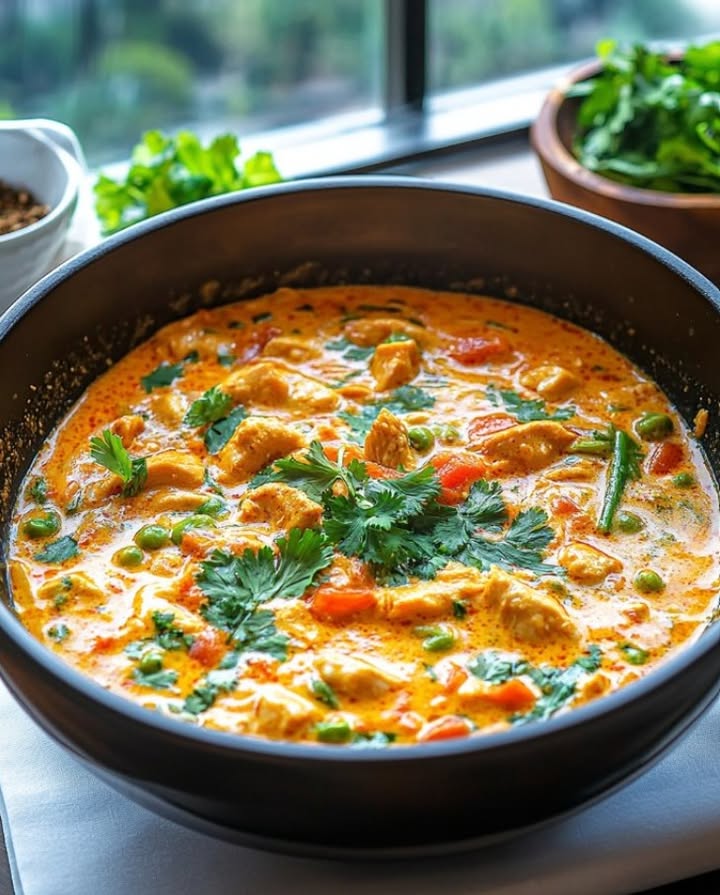
Why Thai Coconut Curry Is a Must-Try Dish
There’s something magical about the aroma of Thai Coconut Curry wafting through the kitchen. It’s like a warm hug on a chilly evening or a tropical vacation in a bowl. I first tried this dish at a friend’s house, and it was love at first bite. The creamy coconut milk, tender chicken, and fragrant spices blended so perfectly that I couldn’t resist recreating it at home. After several tweaks, I finally nailed the recipe, and now it’s a family favorite. Whether you’re new to Thai cuisine or already a fan, this dish is sure to win your heart.
A Little History Behind Thai Coconut Curry
Thai Coconut Curry has deep roots in Southeast Asian cooking. Traditionally, curries were made using fresh curry pastes ground from herbs and spices, then simmered with coconut milk for rich flavor. Over time, this dish spread globally, inspiring countless variations. Some versions are mild, while others pack a spicy punch. My version balances bold flavors with comforting creaminess, making it perfect for both adventurous eaters and those new to Thai food.
Why You’ll Love This Recipe
This Thai Coconut Curry is simple yet bursting with flavor. The combination of garlic, ginger, and curry paste creates a tantalizing aroma, while the coconut milk adds a silky texture. Plus, it’s quick to prepare—perfect for busy weeknights. Best of all, it’s versatile. You can tweak the spice level or swap ingredients based on what’s in your pantry. Trust me, once you try this, it’ll become a go-to recipe.
Perfect Occasions to Make This Recipe
Whether you’re hosting a dinner party or just craving comfort food, this dish fits the bill. It’s great for casual gatherings, potlucks, or even date night. Pair it with steamed rice or crusty bread, and you’ve got a meal that feels fancy but doesn’t require hours in the kitchen. I especially love making it during colder months when the spices warm up the soul.
Ingredients You’ll Need
- 2 to 3 tablespoons of coconut oil or olive oil
- 1 medium/large yellow onion or sweet Vidalia onion, finely chopped
- 450g boneless, skinless chicken breast, cut into bite-sized pieces
- 3 cloves garlic, minced or pressed
- 1 tablespoon red curry paste (adjust to taste)
- 1 can (about 400ml) coconut milk
- 1 cup vegetable broth
- 1 tablespoon fish sauce (optional)
- 1 teaspoon sugar
- Salt and pepper to taste
- Fresh cilantro for garnish
Substitution Options
- Coconut oil: Use any neutral oil if you don’t have coconut oil.
- Chicken: Swap with shrimp, tofu, or beef for variety.
- Fish sauce: Substitute soy sauce for a similar umami kick.
- Vegetable broth: Chicken or mushroom broth works too.
Step-by-Step Preparation
Step 1: Sauté the Aromatics
Heat the oil in a large skillet or pot over medium heat. Add the chopped onion and cook until soft and translucent, about 5 minutes. Stir occasionally to prevent burning. Once the onions turn golden, add the minced garlic and sauté for another minute. The kitchen will fill with an irresistible smell that sets the stage for the curry.
Pro tip: Don’t rush this step. Softening the onions brings out their natural sweetness, which enhances the overall flavor.
Step 2: Cook the Chicken
Add the chicken pieces to the pan and cook until they’re no longer pink, about 6–8 minutes. Break them apart with a spatula to ensure even cooking. The chicken should start browning slightly, adding depth to the dish. If needed, season lightly with salt and pepper here.
Pro tip: Pat the chicken dry with paper towels before cooking to avoid excess moisture in the pan.
Step 3: Build the Curry Base
Stir in the red curry paste and cook for 1–2 minutes to toast the spices. This step unlocks the full potential of the curry paste, making the flavors more vibrant. Pour in the coconut milk and vegetable broth, stirring well to combine. Let the mixture simmer gently for 10 minutes.
Chef’s tip: Taste as you go! Adjust the curry paste or add a pinch of chili flakes if you want more heat.
Step 4: Finish and Garnish
Stir in the fish sauce, sugar, and any additional seasoning. Simmer for another 5 minutes to let the flavors meld together. Before serving, sprinkle fresh cilantro on top for a pop of color and freshness. Serve hot with steamed rice or noodles.
Timing Breakdown
- Prep time: 15 minutes
- Cooking time: 25 minutes
- Total time: 40 minutes
Chef’s Secret
For an extra layer of flavor, roast the garlic cloves before mincing them. Simply toss them with a bit of oil and bake at 400°F for 10–12 minutes. Roasted garlic adds a nutty, caramelized note that elevates the curry.
An Interesting Fact About Coconut Milk
Did you know that coconut milk isn’t actually “milk” in the traditional sense? It’s made by grating the flesh of mature coconuts and mixing it with water. This process extracts the rich, creamy liquid we love in curries and desserts. No wonder it pairs so beautifully with savory dishes!
Necessary Equipment
- Large skillet or pot
- Wooden spoon or spatula
- Sharp knife for chopping
- Cutting board
- Measuring spoons and cups
Storage Tips
Leftover Thai Coconut Curry keeps well in the fridge for up to 3 days. Store it in an airtight container to preserve freshness. When reheating, add a splash of water or broth to loosen the sauce. For longer storage, freeze portions in freezer-safe bags for up to 3 months.
If freezing, label each bag with the date. Thaw overnight in the fridge before reheating. Avoid microwaving directly from frozen, as uneven heating can affect texture.
Tips and Advice
- Use fresh ingredients whenever possible for the best flavor.
- Adjust the spice level to suit your family’s preferences.
- Toast the curry paste briefly to intensify its aroma.
Presentation Ideas
- Garnish with lime wedges and fresh basil leaves.
- Serve in colorful bowls to highlight the vibrant colors.
- Pair with jasmine rice for an authentic touch.
Healthier Alternatives
Here are six ways to make this dish healthier:
- Light Coconut Milk: Swap full-fat coconut milk with light for fewer calories.
- Veggie-Packed Version: Add bell peppers, zucchini, or spinach for extra nutrients.
- Lean Protein: Use turkey breast instead of chicken.
- Low-Sodium Broth: Reduce sodium by choosing low-salt broth.
- No Added Sugar: Skip the sugar if watching carb intake.
- Gluten-Free Option: Ensure all sauces are gluten-free.
Common Mistakes to Avoid
Mistake 1: Skipping the Sauté Step
Some people rush through sautéing the onions and garlic, thinking it won’t make much difference. But this step builds the foundation of flavor. Without it, the curry may taste flat. Take your time to soften the onions properly.
Mistake 2: Overcooking the Chicken
Overcooked chicken becomes dry and tough. To avoid this, remove the curry from heat as soon as the chicken is cooked through. Test a piece to ensure it’s tender and juicy.
Mistake 3: Using Old Spices
Old curry paste loses its potency, resulting in lackluster flavor. Always check expiration dates and store spices in a cool, dark place.
FAQs About Thai Coconut Curry
Can I make this recipe vegetarian?
Absolutely! Replace the chicken with tofu or chickpeas, and use vegetable broth instead of chicken broth. The result will still be deliciously creamy and satisfying.
How spicy is Thai Coconut Curry?
The spiciness depends on the type and amount of curry paste used. Start with 1 tablespoon and adjust according to your tolerance. Remember, you can always add more but can’t take it away!
What side dishes pair well with this curry?
Steamed jasmine rice, basmati rice, or even quinoa complement the curry beautifully. For a low-carb option, serve it with cauliflower rice.
Can I use other proteins besides chicken?
Yes! Shrimp, beef, pork, or even plant-based proteins like tempeh work wonderfully. Just adjust the cooking time accordingly.
Is Thai Coconut Curry gluten-free?
Most recipes are naturally gluten-free, but double-check labels on curry paste and fish sauce to be safe. Opt for certified gluten-free products if needed.
How do I store leftovers?
Store leftovers in an airtight container in the fridge for up to 3 days. Reheat gently on the stovetop or in the microwave, adding a splash of broth if necessary.
Can I freeze this dish?
Yes, it freezes beautifully. Portion it into freezer-safe containers and thaw in the fridge before reheating. Avoid freezing with rice, as it can become mushy.
What’s the best way to reheat the curry?
Reheat gently on the stovetop over low heat, stirring occasionally. Alternatively, microwave in short bursts, stirring between intervals to distribute heat evenly.
Do I need special tools to make this recipe?
No fancy gadgets required! A good knife, cutting board, and sturdy pot are all you need. Keep it simple and enjoy the process.
Where can I find red curry paste?
Look for red curry paste in the international aisle of most grocery stores or at Asian markets. Brands like Mae Ploy and Thai Kitchen are widely available and reliable.
Final Thoughts
Thai Coconut Curry is more than just a dish—it’s an experience. From the moment you start chopping onions to the final garnish of cilantro, every step is rewarding. It’s quick, flavorful, and adaptable, making it a staple in my kitchen. Give it a try, and I’m confident it’ll earn a spot in yours too. Happy cooking!

Thai Coconut Curry
Ingredients
Equipment
Method
- Heat the oil in a large skillet or pot over medium heat. Add the chopped onion and cook until soft and translucent, about 5 minutes.
- Add the minced garlic and sauté for another minute.
- Add the chicken pieces to the pan and cook until they’re no longer pink, about 6–8 minutes.
- Stir in the red curry paste and cook for 1–2 minutes to toast the spices.
- Pour in the coconut milk and vegetable broth, stirring well to combine. Let the mixture simmer gently for 10 minutes.
- Stir in the fish sauce, sugar, and any additional seasoning. Simmer for another 5 minutes.
- Before serving, sprinkle fresh cilantro on top. Serve hot with steamed rice or noodles.
